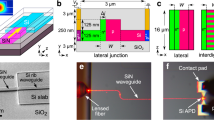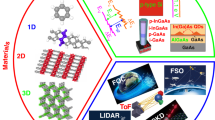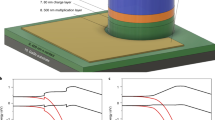Abstract
Avalanche photodiodes (APDs) have enabled highly sensitive photodetection in optical communication, sensing and quantum applications. Great efforts have been focused on improving their gain–bandwidth product (GBP). However, further advance has encountered enormous barriers due to incomplete consideration of the avalanche process. Here we implement a germanium/silicon APD with the GBP breaking through 1 THz. The performance is achieved by introducing two cooperative strategies: precisely shaping the electric field distribution and elaborately engineering the resonant effect in the avalanche process. Experimentally, the presented APD has a primary responsivity of 0.87 A W−1 at unity gain, a large bandwidth of 53 GHz in the gain range of 9–19.5 and an ultrahigh GBP of 1,033 GHz under −8.6 V and at 1,550 nm. For demonstration, data reception of 112 Gb s−1 on–off keying and 200 Gb s−1 four-level pulse amplitude modulation signals per wavelength are achieved with clear eye diagrams and high sensitivity, as well as 800 G reception via four channels. This work provides a potential successor for high-speed optoelectronic devices in next-generation optical interconnects.
This is a preview of subscription content, access via your institution
Access options
Access Nature and 54 other Nature Portfolio journals
Get Nature+, our best-value online-access subscription
$29.99 / 30 days
cancel any time
Subscribe to this journal
Receive 12 print issues and online access
$209.00 per year
only $17.42 per issue
Buy this article
- Purchase on Springer Link
- Instant access to full article PDF
Prices may be subject to local taxes which are calculated during checkout




Similar content being viewed by others
Data availability
The data that support the findings of this study are available from the figures and from the corresponding authors on reasonable request.
References
Assefa, S., Xia, F. & Vlasov, Y. A. Reinventing germanium avalanche photodetector for nanophotonic on-chip optical interconnects. Nature 464, 80–84, (2010).
Jones, A. H., March, S. D., Bank, S. R. & Campbell, J. C. Low-noise high-temperature AlInAsSb/GaSb avalanche photodiodes for 2-μm applications. Nat. Photonics 14, 559–563 (2020).
Bruschini, C., Homulle, H., Antolovic, I. M., Burri, S. & Charbon, E. Single-photon avalanche diode imagers in biophotonics: review and outlook. Light Sci. Appl. 8, 87 (2019).
Hadfield, R. H. Single-photon detectors for optical quantum information applications. Nat. Photonics 3, 696–705 (2009).
Wang, B. et al. A low-voltage Si–Ge avalanche photodiode for high-speed and energy efficient silicon photonic links. J. Lightwave Technol. 38, 3156–3163 (2019).
Kumar, A. et al. Design considerations for energy efficient DWDM PAM4 transceivers employing avalanche photodiodes. Laser Photonics Rev. 14, 2000142 (2020).
Winzer, P. J. & Neilson, D. T. From scaling disparities to integrated parallelism: a decathlon for a decade. J. Lightwave Technol. 35, 1099–1115 (2017).
Richardson, D. J., Fini, J. M. & Nelson, L. E. Space-division multiplexing in optical fibres. Nat. Photonics 7, 354–362 (2013).
Liu, J. et al. 1-Pbps orbital angular momentum fibre-optic transmission. Light Sci. Appl. 11, 202 (2022).
Lischke, S. et al. Ultra-fast germanium photodiode with 3-dB bandwidth of 265 GHz. Nat. Photonics 15, 925–931 (2021).
Cheng, Q., Bahadori, M., Glick, M., Rumley, S. & Bergman, K. Recent advances in optical technologies for data centers: a review. Optica 5, 1354–1370 (2018).
Emmons, R. Avalanche-photodiode frequency response. J. Appl. Phys. 38, 3705–3714 (1967).
Campbell, J. C. Recent advances in telecommunications avalanche photodiodes. J. Lightwave Technol. 25, 109–121 (2007).
Wang, P.-S. et al. Top-illuminated avalanche photodiodes with cascaded multiplication layers for high-speed and wide dynamic range performance. J. Lightwave Technol. 40, 7893–7900 (2022).
Kinsey, G., Campbell, J. & Dentai, A. Waveguide avalanche photodiode operating at 1.55 μm with a gain–bandwidth product of 320 GHz. IEEE Photonics Tech. Lett. 13, 842–844 (2001).
Okimoto, T. et al. 106-Gb/s waveguide AlInAs/GaInAs avalanche photodiode with butt-joint coupling structure. In 2022 Optical Fiber Communications Conference and Exhibition 1–3 (IEEE, 2022).
Yi, X. et al. Extremely low excess noise and high sensitivity AlAs0. 56Sb0. 44 avalanche photodiodes. Nat. Photonics 13, 683–686 (2019).
March, S. D., Jones, A. H., Campbell, J. C. & Bank, S. R. Multistep staircase avalanche photodiodes with extremely low noise and deterministic amplification. Nat. Photonics 15, 468–474 (2021).
Kang, Y. et al. Monolithic germanium/silicon avalanche photodiodes with 340 GHz gain–bandwidth product. Nat. Photonics 3, 59–63 (2009).
Huang, Z. et al. 25 Gbps low-voltage waveguide Si-Ge avalanche photodiode. Optica 3, 793–798, (2016).
Zeng, X. et al. Silicon–germanium avalanche photodiodes with direct control of electric field in charge multiplication region. Optica 6, 772–777, (2019).
Wang, B. et al. 64 Gb/s low-voltage waveguide SiGe avalanche photodiodes with distributed Bragg reflectors. Photonics Res. 8, 1118–1123, (2020).
Xiang, Y., Cao, H., Liu, C., Guo, J. & Dai, D. High-speed waveguide Ge/Si avalanche photodiode with a gain–bandwidth product of 615 GHz. Optica 9, 762–769 (2022).
Benedikovic, D. et al. Silicon-germanium receivers for short-wave-infrared optoelectronics and communications. Nanophotonics 10, 1059–1079 (2021).
Hayat, M. M., Sargeant, W. L. & Saleh, B. E. Effect of dead space on gain and noise in Si and GaAs avalanche photodiodes. IEEE J. Quantum Elect. 28, 1360–1365 (1992).
Saleh, M. A. et al. Impact-ionization and noise characteristics of thin III-V avalanche photodiodes. IEEE Trans. Electron. Devices 48, 2722–2731 (2001).
Dai, D. et al. Resonant normal-incidence separate–absorption–charge–multiplication Ge/Si avalanche photodiodes. Opt. Express 17, 16549–16557, (2009).
Zeng, Q. et al. Space charge effects on the bandwidth of Ge/Si avalanche photodetectors. Semicond. Sci. Tech. 35, 035026 (2020).
Dai, D., Rodwell, M. J., Bowers, J. E., Kang, Y. & Morse, M. Derivation of the small signal response and equivalent circuit model for a separate absorption and multiplication layer avalanche photodetector. IEEE J. Sel. Top. Quant. 16, 1328–1336 (2010).
Kim, G., Kim, I. G., Baek, J. H. & Kwon, O. K. Enhanced frequency response associated with negative photoconductance in an InGaAs/InAlAs avalanche photodetector. Appl. Phys. Lett. 83, 1249–1251 (2003).
Kang, H.-S., Lee, M.-J. & Choi, W.-Y. Si avalanche photodetectors fabricated in standard complementary metal-oxide-semiconductor process. Appl. Phys. Lett. 90, 151118 (2007).
Shi, J.-W., Wu, Y.-S., Li, Z.-R. & Chen, P.-S. Impact-ionization-induced bandwidth-enhancement of a Si–SiGe-based avalanche photodiode operating at a wavelength of 830 nm with a gain–bandwidth product of 428 GHz. IEEE Photonic Tech. Lett. 19, 474–476 (2007).
Zaoui, W. S. et al. Frequency response and bandwidth enhancement in Ge/Si avalanche photodiodes with over 840GHz gain–bandwidth-product. Opt. Express 17, 12641–12649, (2009).
Srinivasan, S. A. et al. 27 GHz silicon-contacted waveguide-coupled Ge/Si avalanche photodiode. J. Lightwave Technol. 38, 3044–3050 (2020).
Srinivasan, S. A. et al. 56 Gb/s NRZ O-band hybrid BiCMOS-silicon photonics receiver using Ge/Si avalanche photodiode. J Lightwave Technol. 39, 1409–1415 (2020).
Decker, D. & Dunn, C. Determination of germanium ionization coefficients from small-signal IMPATT diode characteristics. IEEE Trans. Electron. Devices 17, 290–299 (1970).
Shi, Y., Zhou, D., Yu, Y. & Zhang, X. 80 GHz germanium waveguide photodiode enabled by parasitic parameter engineering. Photonics Res. 9, 605–609 (2021).
Saleh, M. A. et al. Breakdown voltage in thin III-V avalanche photodiodes. Appl. Phys. Lett. 79, 4037–4039 (2001).
Guo, B. et al. Temperature dependence of avalanche breakdown of AlGaAsSb and AlInAsSb avalanche photodiodes. J. Lightwave Technol. 40, 5934–5942 (2022).
Ware, M. et al. Architecting for power management: the IBM® POWER7™ approach. In HPCA-16 2010 The Sixteenth International Symposium on High-Performance Computer Architecture 1–11 (IEEE, 2010).
Benedikovic, D. et al. 40 Gbps heterostructure germanium avalanche photo receiver on a silicon chip. Optica 7, 775–783, (2020).
Wang, B. & Mu, J. High-speed Si–Ge avalanche photodiodes. PhotoniX 3, 1–22 (2022).
Zhu, S. et al. Waveguided Ge/Si avalanche photodiode with separate vertical SEG-Ge absorption, lateral Si charge, and multiplication configuration. IEEE Electr. Device Lett. 30, 934–936 (2009).
Duan, N., Liow, T.-Y., Lim, A. E.-J., Ding, L. & Lo, G. 310 GHz gain–bandwidth product Ge/Si avalanche photodetector for 1550 nm light detection. Opt. Express 20, 11031–11036, (2012).
Kim, G., Kim, S., Kim, S. A., Oh, J. H. & Jang, K.-S. NDR-effect vertical-illumination-type Ge-on-Si avalanche photodetector. Opt. Lett. 43, 5583–5586 (2018).
Nada, M., Yamada, Y. & Matsuzaki, H. Responsivity–bandwidth limit of avalanche photodiodes: toward future ethernet systems. IEEE J. Sel. Top. Quant. 24, 1–11 (2017).
Shi, B. et al. 106 Gb/s normal-incidence Ge/Si avalanche photodiode with high sensitivity. In 2020 Optical Fiber Communications Conference and Exhibition 1–3 (IEEE, 2020).
David, J. & Tan, C. Material considerations for avalanche photodiodes. IEEE J. Sel. Top. Quant. 14, 998–1009 (2008).
Siew, S. Y. et al. Review of silicon photonics technology and platform development. J. Lightwave Technol. 39, 4374–4389 (2021).
Acknowledgements
This work was supported by National Key Research and Development Program of China (2019YFB1803801 received by Y.Y.), National Natural Science Foundation of China (61922034 and 62135004 received by Y.Y.), Key Research and Development Program of Hubei Province (2021BAA005 received by Y.Y.), Innovation Project of Optics Valley Laboratory (OVL2021BG005 received by Y.Y. and X.Z.) and Program for HUST Academic Frontier Youth Team (2018QYTD08 received by Y.Y.).
Author information
Authors and Affiliations
Contributions
Y.S. and Y.Y. jointly conceived the idea. Y.S. conducted simulation and designed the device. X.L. designed the equalization algorithm for high-speed signal reception. G.C. dealt with the chip fabrication. Y.S., M.Z. and H.C. performed the experiments. All authors contributed to the discussion of experimental results. Y.S. and Y.Y. wrote the manuscript with contributions from all co-authors. Y.Y. and X.Z. supervised and coordinated all the work.
Corresponding authors
Ethics declarations
Competing interests
The authors declare no competing interests.
Peer review
Peer review information
Nature Photonics thanks the anonymous reviewers for their contribution to the peer review of this work.
Additional information
Publisher’s note Springer Nature remains neutral with regard to jurisdictional claims in published maps and institutional affiliations.
Supplementary information
Supplementary Information
Supplementary Figs. 1–8 and Tables 1 and 2.
Rights and permissions
Springer Nature or its licensor (e.g. a society or other partner) holds exclusive rights to this article under a publishing agreement with the author(s) or other rightsholder(s); author self-archiving of the accepted manuscript version of this article is solely governed by the terms of such publishing agreement and applicable law.
About this article
Cite this article
Shi, Y., Li, X., Chen, G. et al. Avalanche photodiode with ultrahigh gain–bandwidth product of 1,033 GHz. Nat. Photon. (2024). https://doi.org/10.1038/s41566-024-01421-2
Received:
Accepted:
Published:
DOI: https://doi.org/10.1038/s41566-024-01421-2



